Greetings and salutations, everyone; yes, once again it is I, your popular host, Mani the purebred border collie, here today to bring you a post with the most unusual title ever, for Colorado anyway. You may remember me from such posts as “The Usual Stuff”, among so many, many others.
Here I am in a characteristic pose. 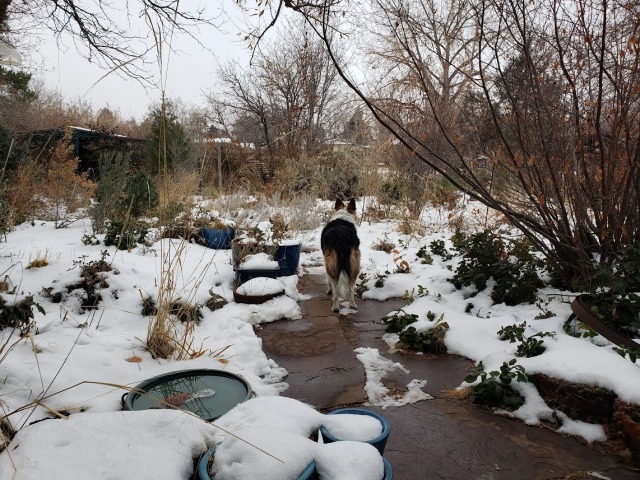 You may notice that you can’t see the foothills, or really much of anything else in the distance, because today has been quite foggy. We almost never have fog here, though the guy I live with says that fog used to be a lot more common here, especially in the wintertime.
You may notice that you can’t see the foothills, or really much of anything else in the distance, because today has been quite foggy. We almost never have fog here, though the guy I live with says that fog used to be a lot more common here, especially in the wintertime.
The temperature is right at freezing, but the humidity is very high, so this is really different for us.
I like this kind of weather.
I thought I might show some pictures of shrubs and conifers, since these don’t always photograph well in our intense sunlight. I know I’ve shown some of these before.
This one didn’t photograph well even today, but it’s an evergreen version of the usually deciduous Cercocarpus montanus, a common shrub in the foothills here.
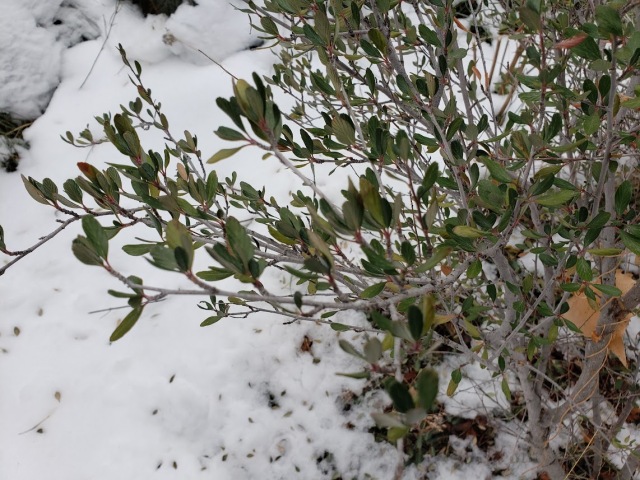
This is a fastigiate form of Cercocarpus ledifolius, which the late Jerry Morris gave to the guy I live with. Unlike me, this is very difficult to photograph. There are gigantic shrubs of this in the front garden. 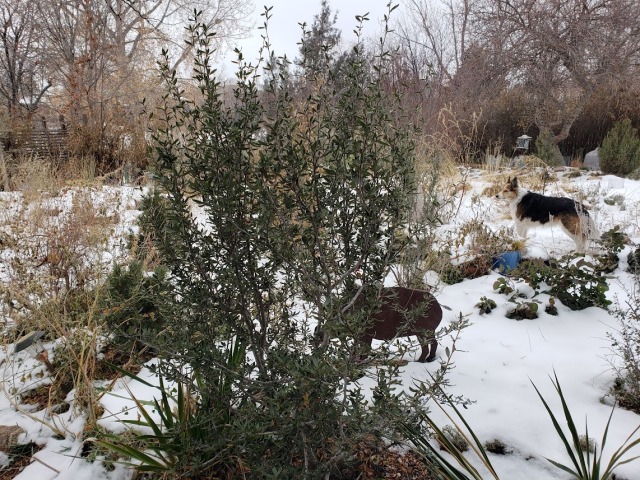 This is another Cercocarpus ledifolius which was given to him by a friend. It’s been plunged, as they say in the U.K., into the soil for the winter.
This is another Cercocarpus ledifolius which was given to him by a friend. It’s been plunged, as they say in the U.K., into the soil for the winter.
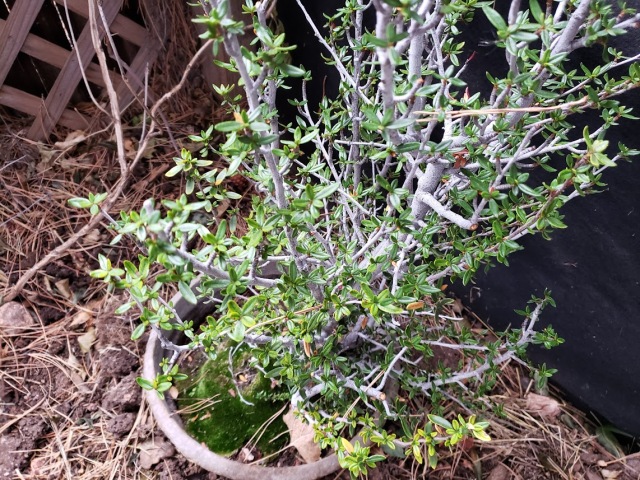 I’ve shown these two dwarf conifers before; they were plunged into the soil after being dug up this past spring, repotted into his “special mix” (just a bunch of soil-less mix saved from troughs).
I’ve shown these two dwarf conifers before; they were plunged into the soil after being dug up this past spring, repotted into his “special mix” (just a bunch of soil-less mix saved from troughs).
 The guy I live with says this is a lot safer method of transplanting evergreen plants, instead of just digging them up and planting them somewhere else. The plants get almost a whole year of being watered and pampered, in partial shade, and then next year they’ll be hardened off to the sun maybe in May.
The guy I live with says this is a lot safer method of transplanting evergreen plants, instead of just digging them up and planting them somewhere else. The plants get almost a whole year of being watered and pampered, in partial shade, and then next year they’ll be hardened off to the sun maybe in May.
One of his late gardening friends, Allan Taylor, told him how to do this.The guy I live with said sometimes the “old ways” are the best.
This is Quercus grisea, a gift from Allan. It’s evergreen, but not totally, here, if we get a really cold spell.
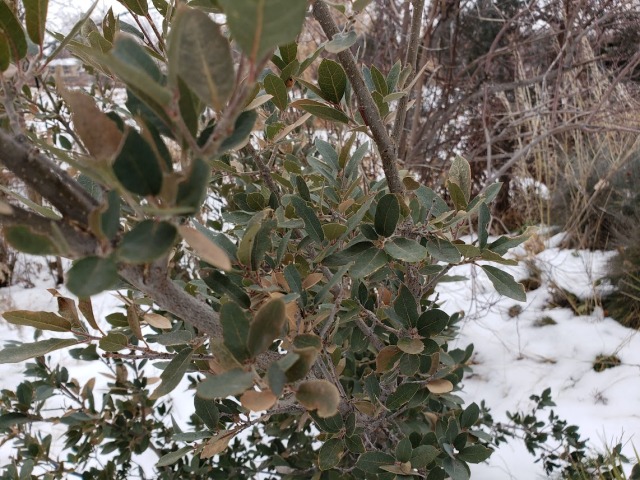 This is the dwarf Pinus aristata he got from Jerry Morris. It’s been growing kind of this way and that, so has been pruned.
This is the dwarf Pinus aristata he got from Jerry Morris. It’s been growing kind of this way and that, so has been pruned.
 And this, also from Jerry, is Picea pungens ‘Blue Beaut’. That’s right, Beaut’, as in “That’s a beaut'”.
And this, also from Jerry, is Picea pungens ‘Blue Beaut’. That’s right, Beaut’, as in “That’s a beaut'”.
This is the first time the guy I live with has gotten a halfway decent picture of this spruce. It’s very blue. He doesn’t know how large it’s going to be.
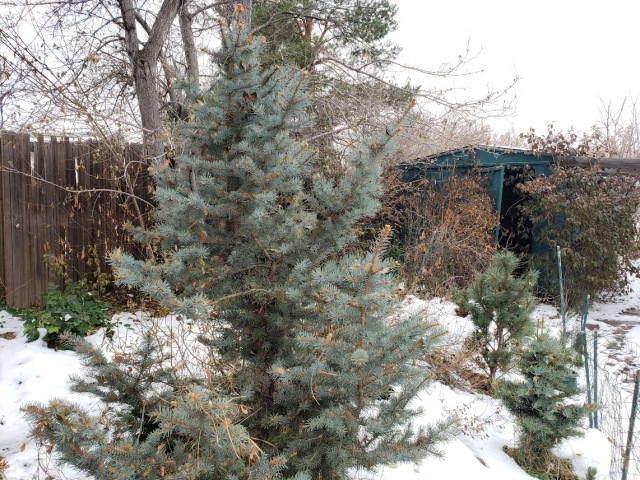 So that was those things. (I hope you enjoy my elegant use of language here.)
So that was those things. (I hope you enjoy my elegant use of language here.)
Believe it or not, we have an Irish yew (Taxus baccata ‘Fastigiata’). It started out growing really slowly ten or so years ago but now it’s been growing faster.
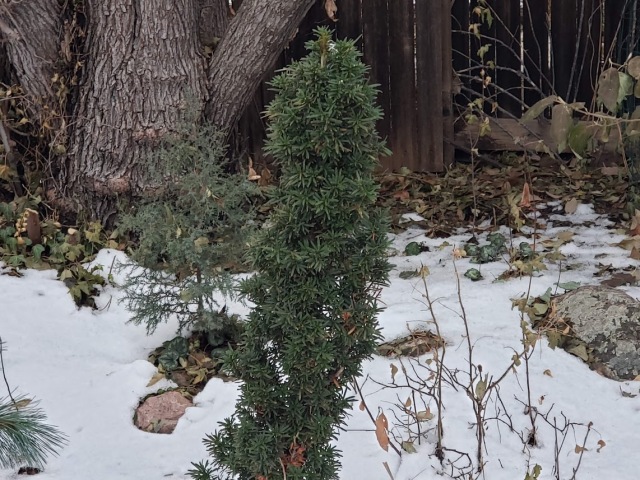 When the guy I live with looked at this picture he didn’t know what the conifer behind it was. Probably a seedling juniper.
When the guy I live with looked at this picture he didn’t know what the conifer behind it was. Probably a seedling juniper.
Saving the large yews for last, the guy I live with is at once very fond of these yews, and at the same time often overlooks them, which is a bit strange.
These are “Hicks” yews (Taxus × media ‘Hicksii’), which are a cross between Taxus baccata and the Japanese T. cuspidata. Red cones are produced every few years, and sometimes there’s damage to the branches on the south side, after a harsh winter, because of our intense sunlight.
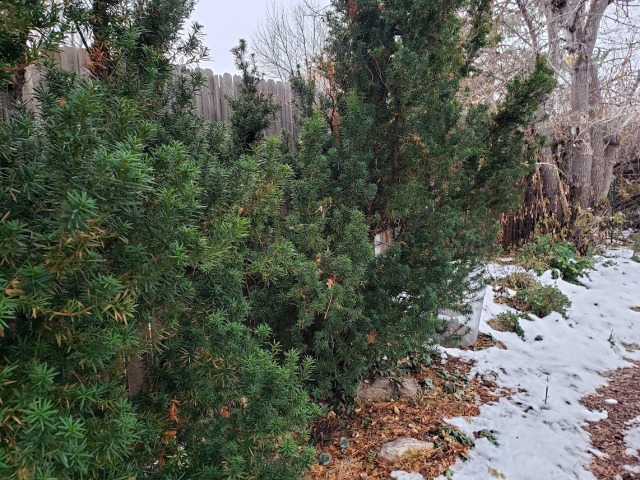 The guy I live with says these are “delightfully somber”, especially in the fog, and wishes there were more. He did plant another one, some years ago, but it died because the yew was rootbound and the “super genius” method hasn’t occurred to him yet. Yews have very serious roots.
The guy I live with says these are “delightfully somber”, especially in the fog, and wishes there were more. He did plant another one, some years ago, but it died because the yew was rootbound and the “super genius” method hasn’t occurred to him yet. Yews have very serious roots.
Most of the cyclamen here are growing at the base of the yews, and then extending all the way to the maple in the background.
That’s all I have for today. I hope you enjoyed the slightly foggy tour around the garden.
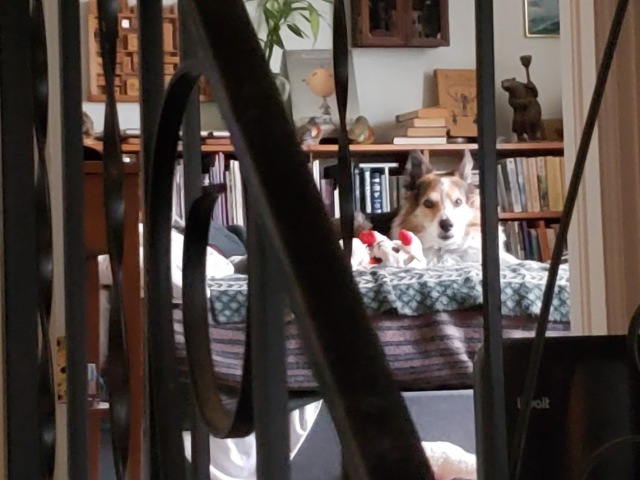
Until next time, then.
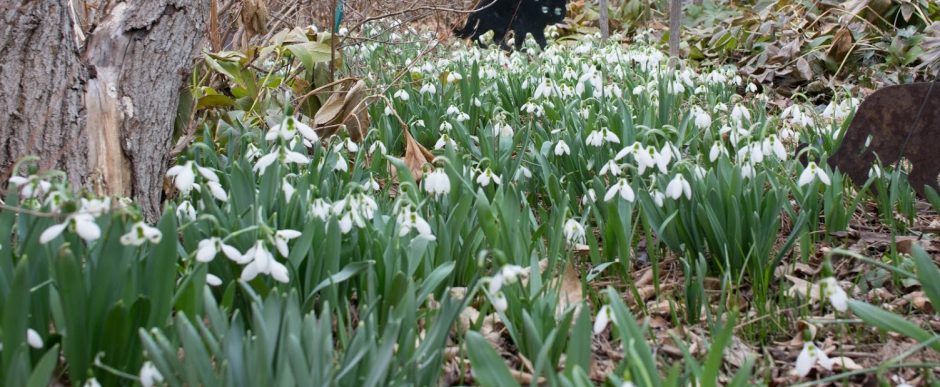
Furabuluss tour of yore foggy an well growin garden Mani!!!
THE dwarf Pinus aristata iss ADOORBSS! Can treess bee adoorbss?? Why not???
An THE Blue Spruce ISS furry blue an lovelee. All yore Yewss are wunderfull…..
Guy you are a pawsum Garnener!
**nose rubss** BellaDharma an (((hugss))) BellaSita Mum
Thanks; the guy I live with said he should have gotten more dwarf conifers from Jerry when he visited the nursery, and now that Jerry is gone his conifers are hard to find, which is sad.
Mistur Jerry’ss Connyfurss ARE lovely inndeed Mani…..
There were a whole bunch to choose from at the nursery. The guy I live with said he should have gotten all of them.
Mew mew mew BellaSita sayss that about clothess…..shee shuuda bott 2 or 3 pairss of Yoga Pantss or Sweaterss….or jewellery…..mew mew mew…. 😉
There is that, too.
Or more treetss fore mee Mani! 😉
More treats are excellent.
Mee agreess Mani! More treetss ISS bettur! 😉
Very true.
What a lovely foggy tour, Mani. I like this weather too.
My young Cercocarpus montanus is most definitely deciduous. I expected it to be evergreen like yours, and the first year I feared I had killed it. But it grew about a foot this past season.
Thanks. There are a lot of regular Cercocarpus montanus in the garden (you can see them behind the dwarf bristlecone in the picture), which are completely deciduous, but there are two that are special, and almost completely evergreen; they came from Jerry Morris who found them somewhere in western North America.
The regular ones have seeded around quite a bit, and the guy I live with dug some up and planted them in the “way back” border.
The guy I live with said the California C. betuloides is more or less evergreen, and very similar to C. montanus. There was one here, but I think it died when it was transplanted, which happens a lot here.
I see the regular ones now behind the bristlecone. Those evergreen ones are special indeed!
They are special, like most of Jerry’s plants. The guy I live with sometimes regrets that he didn’t have ten thousand dollars in his wallet the first time he went there.
You can see his nursery in the post Trip to Jerry’s Nursery, made before purebred border collies did the narration, but still acceptable, I guess.
I found and read the post about Jerry Morris’s nursery. Magnificent. Thank you.
You’re welcome. The guy I live with said it was a very cool place. All of those boxed conifers were left outside all year.
We used to go to https://hicksnurseries.com/about-us/ on Long Island all the time. There were huge Taxus × media ‘Hicksii’ (probably some of the first ones) in the parking lot area. A venerable old nursery that is still run by the family. It’s not far from the Planting Fields Arboretum where they have a spectacular specimen of https://plantingfields.org/sargents-weeping-hemlock/
The guy I live with has been to Planting Fields. Utterly different climate where broadleaf evergreens don’t fry in hot winter sun. And ice storms, too.
Should you ever get to CT, a wonderful place to see some special conifers is: https://magazine.uconn.edu/2019/02/18/conifers/
The guy I live with said the chances of him going to New England again are zero, but thanks anyway.
Your yews are lovely. I would love to have a hedgerow of them on the north side of my property but haven’t got my act together to put them in. And it would be sad if they were slow growers.
Thanks. The guy I live with said you can sometimes see yews around Denver, though not too many. The ones you get at nurseries definitely need to be repotted into larger pots, with the rootball surrounded by very coarse sand or something similar (not “play sand”) and watered for a month or so, so that the roots grow out of the rootball (the “super genius” method), at which point they can be planted in the garden.
They certainly don’t need water in the winter (don’t get the guy I live with going on that) and can tolerate frozen soil, but it would be a very good idea to mulch the soil heavily in the yew’s first and maybe second winters, until the roots get down below any frozen soil.
You can see that our yews are planted on the north side of the fence; full sun in winter would probably be an issue.
No mention of the peculiar thing, the unmentioned thing, the mysterious animal thing in photograph 3, showing the fastigiate form of Cercocarpus ledifolius? Is it a pig?
Sort of a pig; it’s a javelina. Steel. The guy I live with’s wife bought that, and there were like three piglets, or javelinets, which she didn’t buy, but the guy I live with said they would have looked cute.
A little pig could do a lot of damage in the garden!
This one never moves, though it does get blown over by the wind, sometimes.
Ha! The state tree of Colorado!
Uh huh.
I really like Cercocarpuses (Cercocarpi?). I am trying a second C. ledifolius after my first one died before even planting it (don’t ask). I’m glad that someone named Jerry was such a generous person and had great taste in conifers. Something for me to aspire to. I used to eat the fleshy arils from yews when I was in my 20s. And, of course, not the seed itself, which is quite toxic. They were very pleasant. I’m pretty risk adverse now, so not sure it is going to happen again.
The guy I live with said that “cercocarpi” would be acceptable, if weird, because “-carpus” (fruit) is a Latinized version of the Greek “karpos”, so it’s Latin second declension, where the plural is “-i”. (Trees and shrubs are Latin fourth declension, so the plural of cupressus is cupressus.)
The guy I live with said that Jerry Morris was a pretty remarkable person, and he said, as he’s said many times before, talking to him was like talking to Treebeard himself. Allan Taylor, an authority on oaks and other stuff, said that Jerry had a “mental map” of all the witches brooms he’d seen in western North America, and went to fertilize them every year or so.
Jerry had also found clones (the only time the guy I live with can stand to see this ugly word) of aspen which had orange autumn foliage, and red autumn foliage, for twenty years in a row. The guy I live with saw pictures of them.